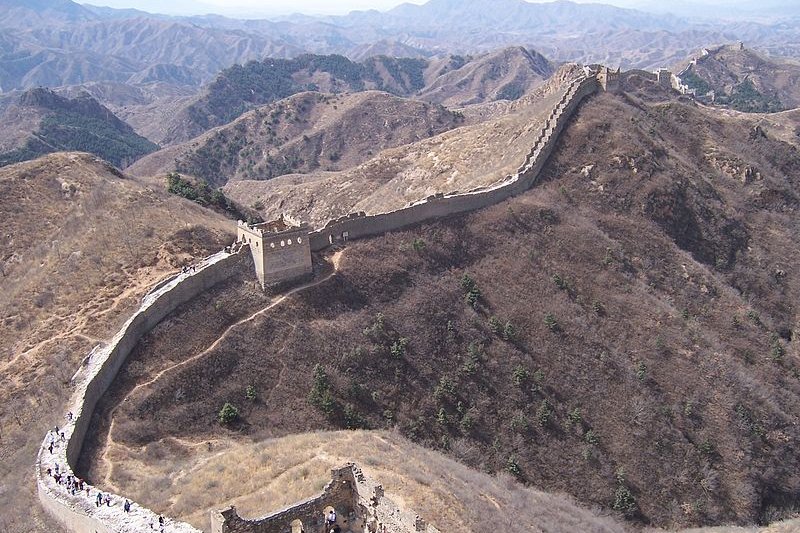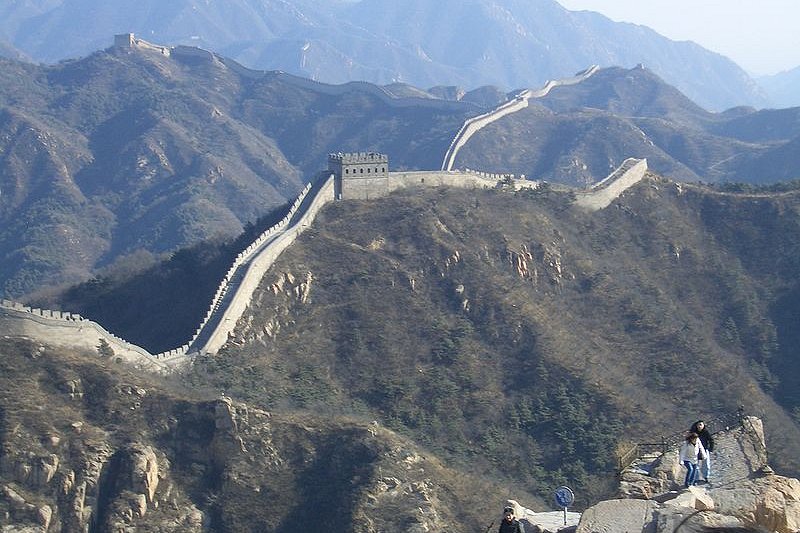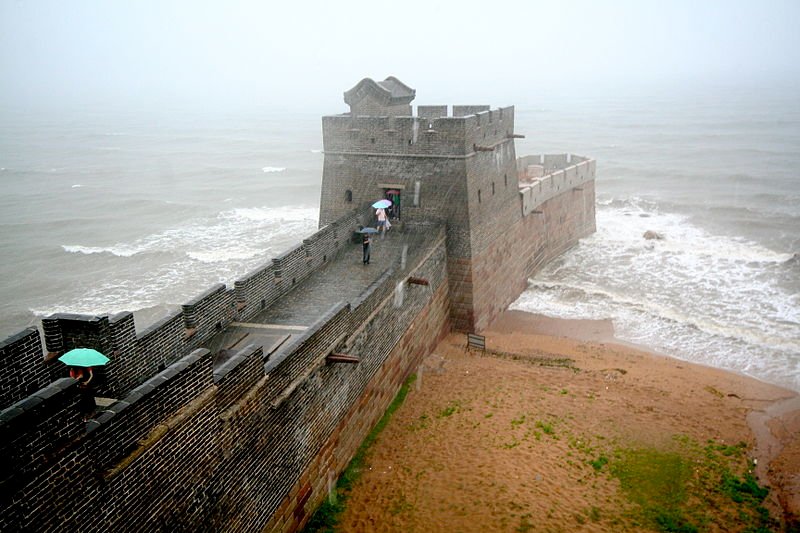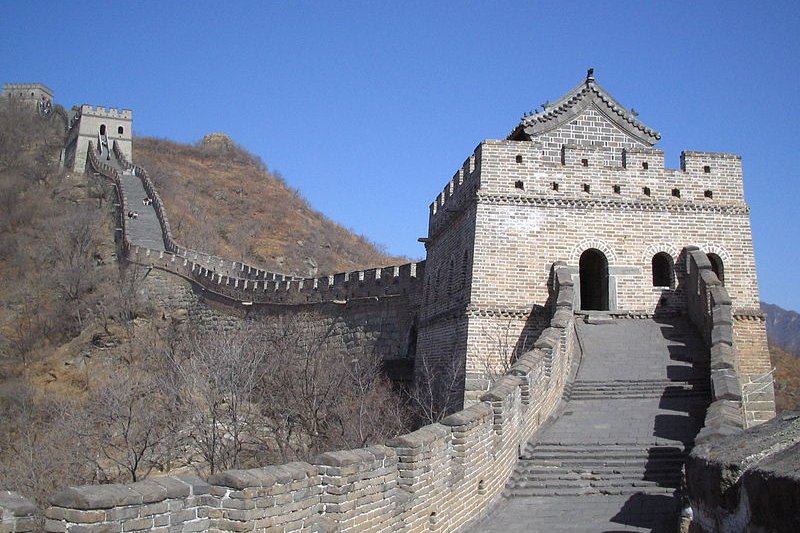

Great Wall of China
 Go Back - Latest PENANG Sights/Streets/New Properties > Malaysia > World | Hokkien : Lessons : Dictionary | YouTube | Facebook | About Me : Contact Me
Go Back - Latest PENANG Sights/Streets/New Properties > Malaysia > World | Hokkien : Lessons : Dictionary | YouTube | Facebook | About Me : Contact Me Great Wall of China
Great Wall of ChinaSource: https://commons.wikimedia.org/wiki/File:China_-_Great_Wall_8_(134019477).jpg
Author: McKay Savage

The Great Wall of China is the longest man-made structure of the ancient world. Called Chángchéng, or "Long Wall" in Mandarin, the Great Wall is actually a series of stone and earthen fortification. It was built, rebuilt and maintained from the 5th century BC to the 16th century AD, to protect the northern border of the Chinese Empire from marauders. The wall totals over 4000km in length, but is not one wall, but several. The current wall was built during the Ming Dynasty. Contrary to popular myth, it is not visible from space.
The Great Wall of China was inscribed as a World Heritage Site during the 11th session of the World Heritage Committee meeting at UNESCO Headquarters in Paris, France, on 7-11 December, 1987.
 Great Wall of China
Great Wall of ChinaSource: https://commons.wikimedia.org/wiki/File:Gran_Muralla_China5173.JPG
Author: Poco a poco

World Heritage Site Inscription Details
Location: N 40 25 E 116 05 in the provinces, municipalities and autonomous regions of Liaoning, Jilin, Hebei, Beijing, Tianjin, Shanxi, Inner Mongolia, Shaanxi, Ningxia, Gansu, Xinjiang, Shandong, Henan, Hubei, Hunan, Sichuan, and QinghaiInscription Year: 1987
Type of Site: Cultural
Inscription Criteria: I, II, III, IV, VI
History of the Great Wall of China
Wall-building techniques were developed as early as (and probably earlier than) the 8th century BC. In the 5th century BC to 221 BC, several ancient states including Qi, Yan and Zhao were all building earthen fortifications to withstand attacks of small arms like swords and spears. When Qin Shi Huang unified China and established the Qin Dynasty in 221BC, he destroyed sections of the wall that divided his empire, and built as new wall to connect the fortifications along his northern frontier. Very little of Qin Shi Huang's wall remained today. Later dynasties continued to repair, rebuilt and extended sections of the Great Wall in a continuous effort to defend themselves. Eastern end of the Great Wall at Shanhaiguan
Eastern end of the Great Wall at ShanhaiguanSource: https://commons.wikimedia.org/wiki/File:ShanhaiguanGreatWall-end.jpg
Author: fuzheado

The Mings overcame the Mongols in 1449 to establish the Ming Dynasty. As the Mings failed to gain a clear victory, there were successive battles in the Mongols. So the Mings adopted a new strategy to keep the Mongols out, by constructing walls alll along the northern border of China. The Ming fortifications were stronger and more elaborate that the Qin. It make use of bricks and stones instead of earth. A lot of effort was invested to upkeep the wall to prevent Mongol intrusion.
From 1600 onwards, the Mings face a new threat, in the form of the Manchus. The Great Wall was able to keep the Manchus at bay until 1644, when a corrupt Ming border general by the name of Wu Sangui opened the gates of Shanhai Pass to the invaders. The Manchus swiftly grab hold of power, defeating the Mings, and establishing the Qing Dynasty, which continued until the Republican revolution in the 20th century. Under the Manchus, repair work on the Great Wall came to a stop because by then, the borders of China had extended northwards beyond the walls, and Mongolia was made part of the empire, so the wall was no longer a necessity.
 The Great Wall at Mutianyu, near Beijing
The Great Wall at Mutianyu, near BeijingSource: https://commons.wikimedia.org/wiki/File:Chemin_de_ronde_muraille_long.JPG
Author: Fabienkhan

Visiting Great Wall of China, Beijing
There are three sections of the Great Wall that are usually visited by tourists to Beijing. They are:The North Pass of Juyongguan, also known as Badaling. This section was the first to open to tourists, in 1957, and remains the most visited section of the Great Wall of China, probably also the most commercialised. Located 50km northwest of Beijing, this is the section of the wall built during the Ming Dynasty.
Jinshanling, the section of the Great Wall in Ruanping county, 120km northeast of Beijing. The Jinshanling section is 10.5km long. It has 5 passes, 67 towers and 2 beacon towers. One striking aspect of the Great Wall here is the steep inclinations that it climbs.
List of World Heritage Sites in China
 Latest updates on Penang Travel Tips
Latest updates on Penang Travel Tips
 Discover with Timothy YouTube Channel
Discover with Timothy YouTube Channel
 PG Food Channel
PG Food Channel
 Learn Penang Hokkien YouTube Channel
Learn Penang Hokkien YouTube Channel
 SojiMart Videos
SojiMart Videos
 Share your travels and/or ask a travel-related question
Share your travels and/or ask a travel-related question
Join the Penang Travel Tips Facebook Group to share photos, tips and anything related to your travels, or ask travel-related questions.
 Map of Roads in Penang
Map of Roads in Penang
Looking for information on Penang? Use this Map of Roads in Penang to zoom in on information about Penang, brought to you road by road. Discover with Timothy
Discover with Timothy
Let me take you to explore and discover Penang through my series of walking tours on YouTube. You may use these videos as your virtual tour guide. At the beginning of each video, I provide the starting point coordinates which you may key into your GPS, Google Maps or Waze, to be navigated to where I start the walk, and use the video as your virtual tour guide.Disclaimer
Please use the information on this page as guidance only. The author endeavours to update the information on this page from time to time, but regrets any inaccuracies if there be any.Latest from Discover with Timothy: Gurney Bay - what to see and do there
About this website

Hello and thanks for reading this page. My name is Timothy and my hobby is in describing places so that I can share the information with the general public. My website has become the go to site for a lot of people including students, teachers, journalists, etc. whenever they seek information on places, particularly those in Malaysia and Singapore. I have been doing this since 5 January 2003, for over twenty years already. You can read about me at Discover Timothy. By now I have compiled information on thousands of places, mostly in Peninsular Malaysia and Singapore, and I continue to add more almost every day. My goal is to describe every street in every town in Malaysia and Singapore.
Robbie's Roadmap
- Episode 1: Robbie's Journey to Financial Freedom
- Episode 2: Lost in America
- Episode 3: The Value of Money
- Episode 4: The Mentor
- Episode 5: The Thing that Makes Money
- Episode 6: The walk with a Billionaire
- Episode 7: The Financial Freedom Awakening
- Episode 8: Meet Mr Washington
- Episode 9: The Pizzeria Incident
Copyright © 2003-2024 Timothy Tye. All Rights Reserved.